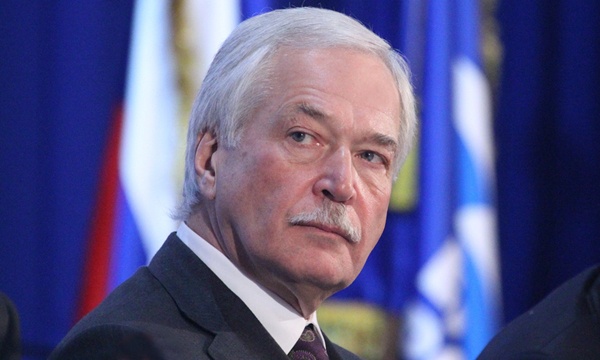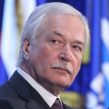
Donbas Fields Have Frozen Over, but for Now the Ceasefire Holds
Publication: Eurasia Daily Monitor Volume: 13 Issue: 14
By:

One year ago, bloody battles raged throughout the eastern Ukrainian region of Donbas. The traditional autumn “rasputitsa” (mud season) usually ends by January: The dirt freezes, allowing trucks, troops and heavy military equipment to maneuver through fields and use unpaved roads. By mid-January 2015, the Donbas separatist forces—armed, trained, led and often reinforced in battle by the Russian military—began a major offensive to capture the main terminal building of the Donetsk international airport, which was the scene of many months of pitched fighting. The joint Russian-separatist forces also attacked the crossroads town of Debaltseve, northeast of Donetsk, which had been held by Ukrainian troops deep inside separatist-controlled territory. By February 18, 2015, both military objectives were secured: The Ukrainian forces were defeated and fell back after suffering heavy losses. But the overall morale of the Ukrainian military did not collapse, and the regime in Kyiv did not disintegrate. Ukraine continued to push away from Russia, seeking integration with the West and Europe. A tactical battlefield success did not bring any significant strategic dividend for Moscow.
In mid-February 2015, after threatening President Vladimir Putin with more severe economic sanctions, France and Germany brokered a compromise, 13-point peace roadmap known as Minsk Two. This document envisaged a ceasefire, a mutual prisoner of war (POW) exchange, constitutional reform in Ukraine to give more autonomy to Donbas and other regions, an amnesty, the withdrawal of foreign forces, free legitimate elections, humanitarian relief, and economic reconstruction and restoration of full Ukrainian control of the border between Donbas and Russia to stop the contraband of weapons and fighters. The implementation of Minsk Two has since been deadlocked and has been prolonged into 2016. Still, no major pitched battles occurred in Donbas since the fall of Debaltseve, and the line of separation more or less holds. Some heavy weapons have been withdrawn from the front, but constant ceasefire violations still happen, with both sides accusing each other. The POW exchange is not complete, though talks to implement Minsk Two continue on a regular basis in Minsk. Moscow and the West as well as Kyiv and the separatists accuse each other of failing to implement the agreement. The Donbas region did not deescalate into a so-called “frozen conflict” like in Transnistria, Abkhazia or Cyprus. The protagonists seem to be ready to resume large-scale hostilities at a moment’s notice (Kommersant, December 25, 2015).
This past December, Putin upgraded the Russian delegation to the Minsk Two implementation talks (“Contact Group”) by appointing Boris Gryzlov as chief negotiator. Gryzlov (65) is a former minister of interior and Duma speaker, and a prominent member of Putin’s St. Petersburg clan. After leaving the Duma in December 2011, Gryzlov retained the position of permanent member of the Russian Security Council—Putin’s de facto inner cabinet. Gryzlov is not known as an experienced diplomatic negotiator, but he can surely directly connect with Putin. His appointment has been interpreted as a signal that Moscow is seriously seeking a peaceful compromise resolution to the Ukrainian crisis (Kommersant, January 14).
On January 12, Gryzlov flew unannounced to Kyiv for secret talks with President Petro Poroshenko. On January 14, in Minsk, attending his first post-appointment meeting of the Minsk Two Contact Group, Gryzlov called for a renewed full ceasefire or “regime of silence” approved by all sides; but shootings and skirmishes in Donbas continued unabated the next day, with both sides blaming each other. Gryzlov later accused Ukrainian volunteer battalions of possibly not obeying orders. He also continued to insist the Minsk Two negotiations are not deadlocked: “There are many ways toward a breakthrough, and my task is to guide the negotiators” (Kommersant, January 17).
On January 15, the United States’ Assistant Secretary of State Victoria Nuland and Putin’s aide Vladislav Surkov met in Kaliningrad oblast and reportedly “constructively” discussed Ukraine. Rumors spread in Moscow and Kyiv that a major US-Russian compromise was imminent, that pressure would be applied to force Ukraine into making political concessions, that Russian sanctions would be lifted, and that, with its finances and economy in turmoil, the Kremlin was seeking a face-saving way out of the Donbas mess (Moskovsky Komsomolets, January 17). The rumors of a possible breakthrough turned out to be premature: On January 20, in Minsk, the Ukrainian delegation accused the separatists “of making unacceptable demands preventing further POW exchanges.” According to the Ukrainian chief negotiator, former president Leonid Kuchma, “Without a ceasefire ‘regime of silence,’ without a verified withdrawal of heavy weapons, without restoring Ukrainian control of the [Donbas] border, it is impossible to have elections in Donbas or change the [Ukrainian] constitution or achieve any other significant progress.” The Ukrainian Supreme Rada (parliament) has reportedly postponed, possibly until next September, a vote on constitutional changes to grant Donbas additional autonomy (RIA Novosti Ukr, January 20).
Economically, Ukraine and Russia are at war. To protest the implementation of the free trade agreement between the European Union and Ukraine, Russia has imposed a wide-ranging trade embargo, also restricting Ukrainian goods transiting through Russian territory. Ukraine has, in turn, imposed its own countersanctions. Ukraine has stopped buying Russian natural gas and demanded that Gazprom pay more for gas transit through Ukraine to Europe. Gazprom in turn demands Ukraine pay billions of dollars in fines for gas it failed to purchase (Newsru.ua, January 20; see EDM, January 20). The proposed association and free trade agreement between Ukraine and the EU infuriated Putin in the fall of 2013; Russian pressure not to sign triggered the Maidan revolution in February 2014 that overthrew Ukrainian president Viktor Yanukovych, which in turn provided Putin with a purported pretext to annex Crimea in March 2014 and support a separatist rebellion in Donbas.
Preventing Ukraine from integrating with the West in any form is the Kremlin’s core strategic objective that may be achieved using a variety of tactical moves. The Minsk Two process could be used to transform the Ukrainian constitution and political regime; Gryzlov may try to bully Poroshenko into submission; while economic sanctions and blockades are a powerful tool to destabilize and change Ukraine. Surkov may try to coerce Washington to abandon the unruly Ukrainians to their fate and dismantle the sanctions. But if all this does not work, the military option is always there and ready. Under Moscow’s orders, a comprehensive ceasefire or “regime of silence” has been fully observed, but this could change at the Kremlin’s whim. Midwinter has come again to Donbas: the dirt is frozen and, according to Ukrainian military intelligence, separatist tank units are field-training in offensive formations (Newsru.ua, January 20).




